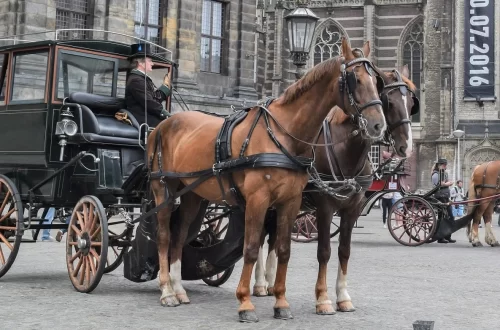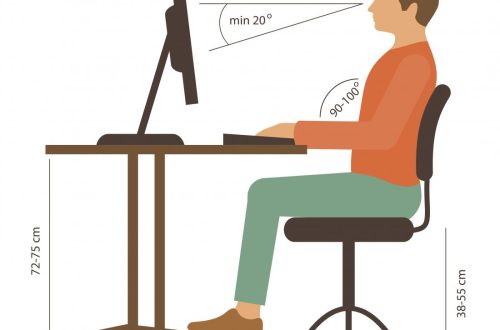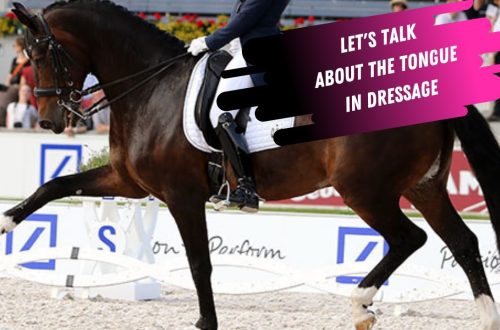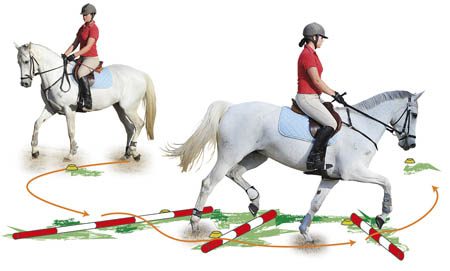
Exercises to Improve the Horse’s Jumping Style
Exercises to Improve the Horse’s Jumping Style
Exercise 1. STICKS
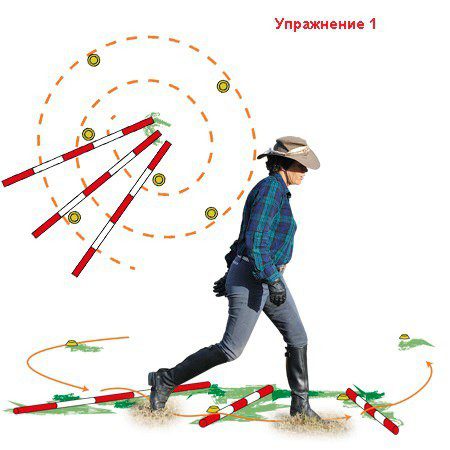
Training a jumping horse involves working on straightening it. We will also start with the development of straightness.
Work on the poles in two directions. It may seem strange to you to suggest that you work on straightening the horse on arcs and circles. However, once you try it, you will see that it works!
Straightness is the ability to focus on a straight line. The curve is a more complex element. This exercise has the benefit of not only leveling the horse, but also getting him to work harder with his inside hind leg. The rider is required to concentrate on the correct use of the controls. In order to maintain flexion and movement in an arc, you need to correctly dose the influence of the inside leg and outside rein. Although this exercise looks simple from the outside, it is not. By doing it, the rider can learn a lot.
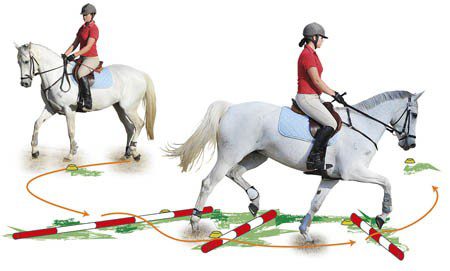
Start walking on the poles so that the horse gets used to and understands what you are asking him to do. You can put markers to help you stick to the center. Once the rider and horse are working in the center with ease, the markers can be removed.
The distance between the poles is about 1,2 m, but it is not critical, because. riders can choose where to go.
The prerequisites for riding are straight forward movement, balance and contact with the horse.
Exercise 2. TURNING JUMPS FROM THE CORNER: single obstacle driving to the right.
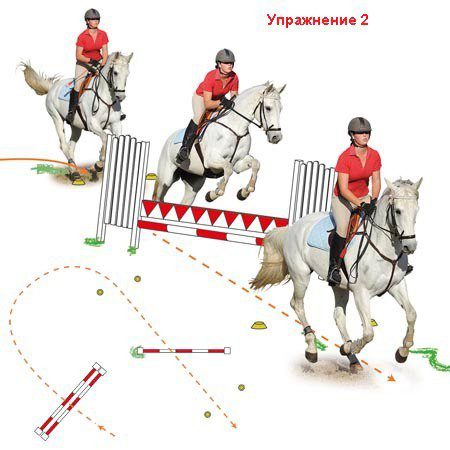
Again, to help the rider, we use markers.
It’s amazing, but when riding into a corner, sitting in a light or jumping seat, you can actually feel the horse deviate from the line. If you are sitting in the saddle, it does not feel so pronounced. As the horse deviates from the line, the rider learns to work his legs and force the horse to activate his hindquarters to ride forward. Many riders “relax” after passing an obstacle, don’t think about handling the angle properly, maintaining pace and rhythm, moving forward, everything that happens between the two barriers.
When you feel that the horse is deviating from the path, keep the body and neck straight. You have no idea how important the focus of the rider’s eyes on the trajectory of movement is. You have to look where you want to ride – this will allow you to optimally lead the horse from one obstacle to another.
If you are serious about show jumping, then you simply must master the lightweight two-point landing. It is only correct when you are not using the horse’s reins and mouth to maintain balance and remain above the horse’s center of gravity. This landing causes the best use of the legs. Riders find themselves doing good leg work while in the saddle. But even if you go through a corner in a light seat, and then sit in the saddle and tighten the horse with your foot, the horse will still be behind your aids, behind your legs. When you ride in a light seat, you will quickly know whether the horse is behind or in front of the leg. To develop your balance and balance, you can use a neck strap in the initial stages. Trotting on the poles in a two-point landing is a great exercise to improve balance. You will learn how to distribute weight evenly, develop an independent fit.
If a rider is having problems with their seat, I recommend working on it, because it is with a “short” and tight leg that a lot of problems are associated. The rider is unable to relax the leg and let the weight go through the heel, which affects their balance.

Exercise 3. CHANGING THE PACE: simple system (at the entrance the obstacle is lower, at the exit it is higher).
In this exercise, the distance between the obstacles is 9 m. This is either two short paces (towards you) or one long one (away from you).
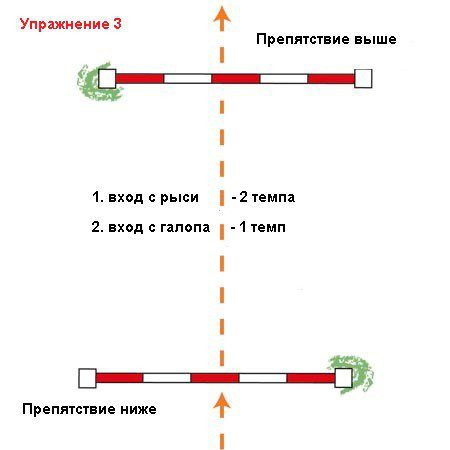
When approaching an obstacle at a trot, one can be in a three-point or two-point landing. Many riders prefer to sit in a three-point position as it is more stable. But keep in mind: the three-point landing must be correct, the rider sits in the center of the saddle in balance.
If you enter the first obstacle at a trot, you will need to do two canter strides before the second one. After jumping over the second obstacle, continue to gallop and go back to it. Now between the obstacles it will be necessary to make one gallop pace. In fact the distance chosen is such that the horse will try to offer one regular pace and one short overtempo. To get one pace, try to expand the canter, go away from yourself.
This is just one of the methods for doing the exercise. You can work with this system in the same way as with a single barrier. You can work out various login options. Colleen Brooke writes that in training with George Morris, the first obstacle at the beginning of training was the oxer, which invites and stimulates the horse to jump.

George was always talking about the ability of the rider to get the horse moving, especially in the turns (half halts in the corner and advance out of the corner). You must pass the corner as if you were demonstrating dressage work. Ann Honner (Australian Grand Prix Dressage Athlete) says that there are about 70 corners and turns in dressage riding and it is therefore the responsibility of the rider to navigate them competently. Riding in corners and corners is not just about “pulling the horse and pushing it”. Riders must be able and aware of how to handle corners and turns properly.
As in every science, mastery is impossible without knowing the basics. With experience, you accumulate more and more knowledge and skills. When you first start out, you often try to take on difficult things. They do not work, but you are not yet developed enough to realize this. Over time, knowledge and understanding of how much more needs to be mastered comes.
Exercise 4.
To perform this simple but effective exercise, which allows you to master the basic skills of overcoming obstacles, you will need only one snuff and one oxer, located in an arc.
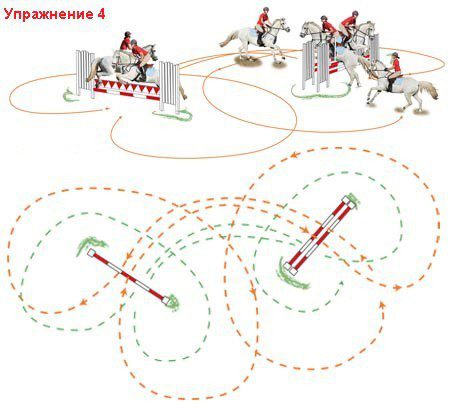
Your goal will be to connect these two obstacles. By doing this exercise, you will be able to practice changing the curvature of the approach to the obstacle, learn to play with the distance. While you are riding around obstacles, you have time to get yourself and the horse in order, to even out breathing, to regain control if lost.
You can ride from the center to the center of the obstacles in a nearly straight line or add a curve to increase the number of canter strides and make the task easier. If the distance is 5 paces, then we can increase and decrease it by changing the curvature of the arc. Change approaches and the order of obstacles: you can have countless plans for passing them.
The exercise will also be useful for strengthening the self-confidence of both the rider and the horse.
When you learn how to easily perform jumps along simple trajectories, you can increase the difficulty – change the number of paces, reducing them.
What requirements does the route put forward for you at competitions? Be able to turn your horse, change the trajectory and speed of movement. You can hone these skills by including this exercise in your training system.
GYMNASTICS FOR CLEANING
The roots of the desire for neatness lie in the horse’s instinct for self-preservation, combined with his sense of trust in the rider. This allows the horse to jump without catching or breaking obstacles. There are horses that push against the barrier, and many riders try to hold them back. Getting the rider to let go of the horse is very difficult. It’s not in our nature, we can’t let go. But as soon as you let go, you stop concentrating on your horse’s head, attention moves to the back and lower back, the horse begins to breathe, to think. Whenever the rider interferes with the rein, the horse stops thinking. When you look at the riding of riders like Markus Ehning, you see how easily they go through the route, how calmly they lead the horse. It’s rare to see Marcus’ horses in soap.
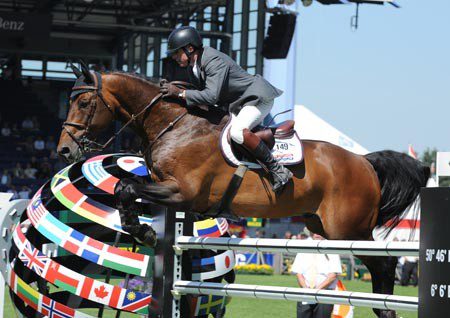
“Keep it simple, keep it simple” – John Whitaker
One of the favorite sayings of George Morris (coach and judge (USA), one of the founders of show jumping, Olympic Gold medalist in 1960) is “John Whitaker makes riding easy for the horse.” Whitaker’s ride is similar to Ehning’s: the viewer gets the impression that the rider is just sitting on the horse, it moves so easily and naturally along the route.
Gymnastics is very important for developing accuracy. Make the distances between obstacles not too extreme so as not to intimidate. Many worthy books and articles have been written about gymnastic exercises. You can train a horse from a trot or a canter, there are gymnastics that shorten the pace, there is an increase. It seems that Michel Robert owns the wonderful words: “We lengthen the pace of an inexperienced horse and shorten the pace of an experienced one.”
If you are consistent, gymnastics will teach the horse to be neat. Your task is to keep the horse balanced, to bring him to the center and to give him the opportunity to think and understand.
The rows are a great gymnastic exercise, but you will need a lot of poles and time and space to form obstacles.
I try to always have one gymnastic combination that I can work on in trot and canter. In the case of a horse throwing a hurdle, I use poles placed on the ground between the hurdles. If you remain calm, the horse will also gradually begin to calm down and approach the take-off point more calmly. Usually, one or two training sessions are enough to correct a horse, and about six to correct a rider who is used to holding him. If you are pulling the horse by the mouth, pushing with your leg, swinging in the saddle and constantly shifting your balance, then how are you going to jump? The horse falls down and the rider blames it. If you give the horse the opportunity to think, if you guide it, tell it, don’t fight, then 9 times out of 10 it will jump cleanly.
Albert Wurn always said, “We have to eliminate tug of war and wrestling from our riding.”
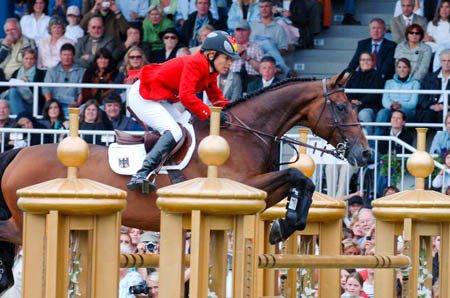
Shutterfly is a fast thinking horse.
The higher the level of your upcoming competition, the less suitable you are for a slow-thinking horse. But the trouble is that not many riders are satisfied with such a horse. In general, athletes prefer horses that are neither too slow nor too fast. Horses either knock down two or three obstacles before they realize that they need to raise their legs higher, or they are so impulsive that they knock everything down in their path due to excitement and excessive effort. I always tell riders, “You have to give your best.” If this does not work, then think about it, you need to change something. As George Morris said: “Never be sure that you can be better than your horse.” Instead of blaming the horse, improve your riding and skills. The result may pleasantly surprise you.
At one of the stages of the World Cup in triathlon, there were two obstacles on the route, located at a very sharp angle to each other. At first glance, it seemed that the horses were supposed to jump first, run back and come out on second, but the couples jumped in a straight line and almost everything was successful. Many show jumpers could learn from such pairs. Everything happened very quickly and on absolute trust: the riders gave the horse freedom of choice without holding them back, and the horses calculated the most convenient take-off point with lightning speed and entered the jump. This is what you should strive for!
Colleen Brook is an Australian top-level show jumper, representing the country in national and international tournaments, and is engaged in coaching.
Translation by Valeria Smirnova (based on materials from the site http://www.horsemagazine.com).
Photos by Roz Neave.



